History
The Ayrshire breed originated from the montainous regions of the Ayr county in Scotland, a country where the topography varies from sea level up to 2000 feet in the montains. The weather is constant from summer through winter, not too warm nor too cold.
The breed developed its red and white caracteristics around the year 1800 but was only recognized in 1814. The breed arrived in Canada in the early 1800 through Scottish settlers. In 1870, the Association of Importers and Ayrshire Breeders of Quebec was founded.
In Ontario, the Canadian Ayrshire Association was founded in 1872. It was only on March 10, 1898 that those two associations merged to become the Ayrshire Breeders’ Association of Canada.
The Association was incorporated on January 1, 1901.
The Canadian Ayrshire breed is famous throughout the world as a genetic source of dairy cattle of superior quality. Ayrshire cows have the milk production and high component level in milk needed to satisfy the world’s market demand. The Ayrshire breed has the lowest somatic cells count in Canada.
They are famous for their functionnal conformation, are free of genetic disease, have easy calvings and are adapted to variable environmental conditions, even difficult ones.
From yesterday to today

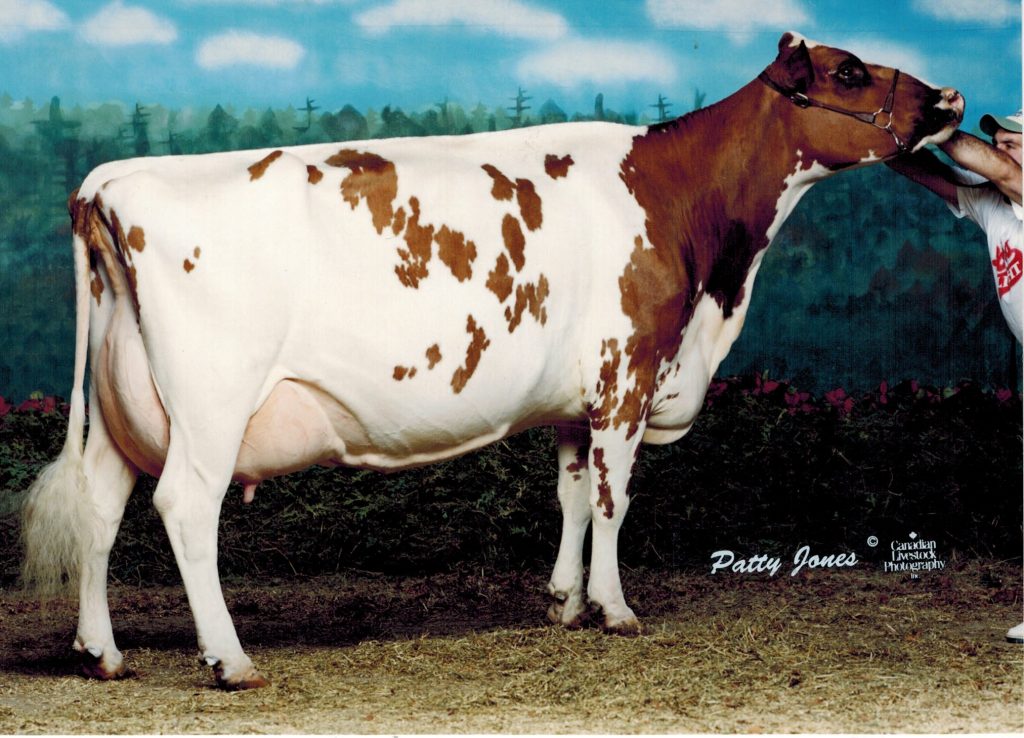
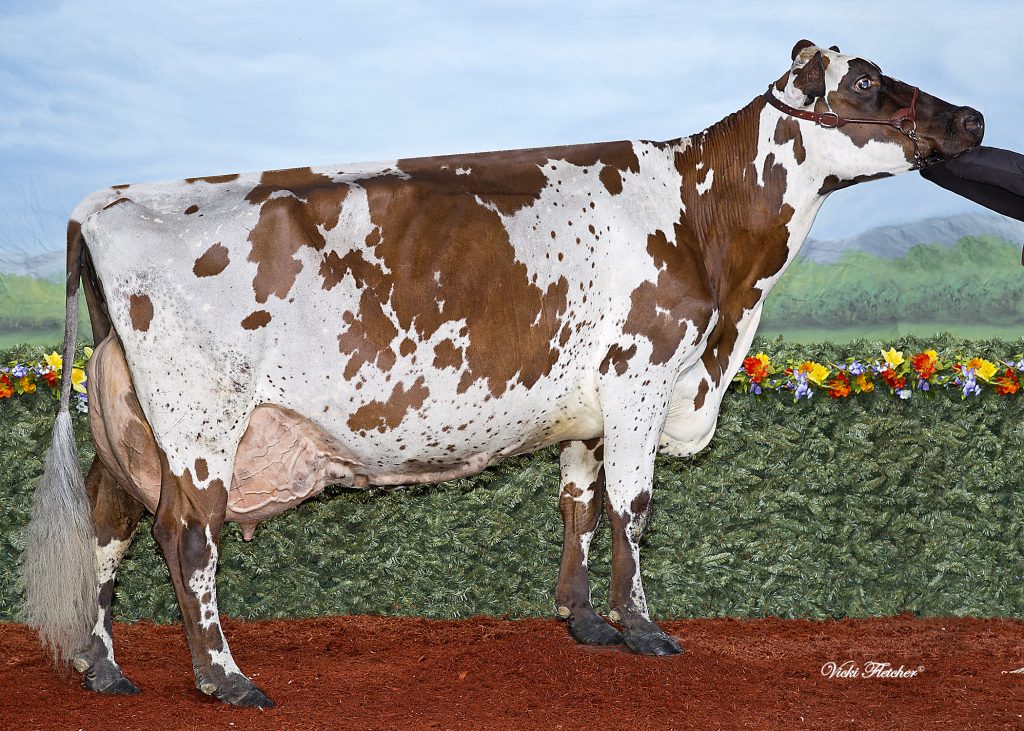
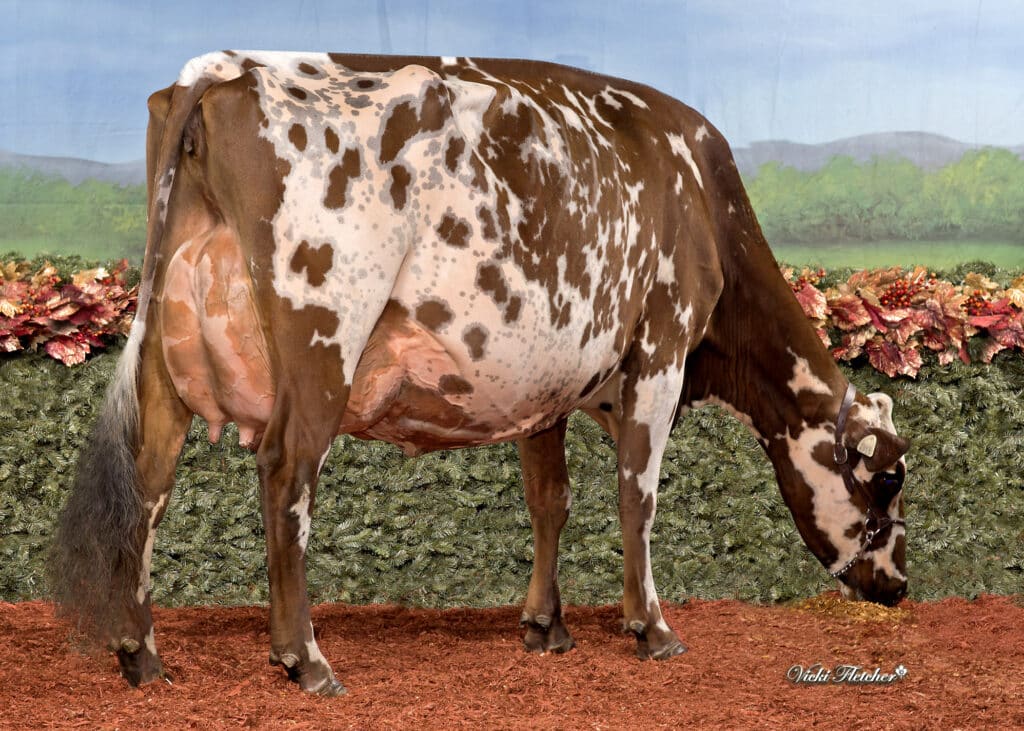
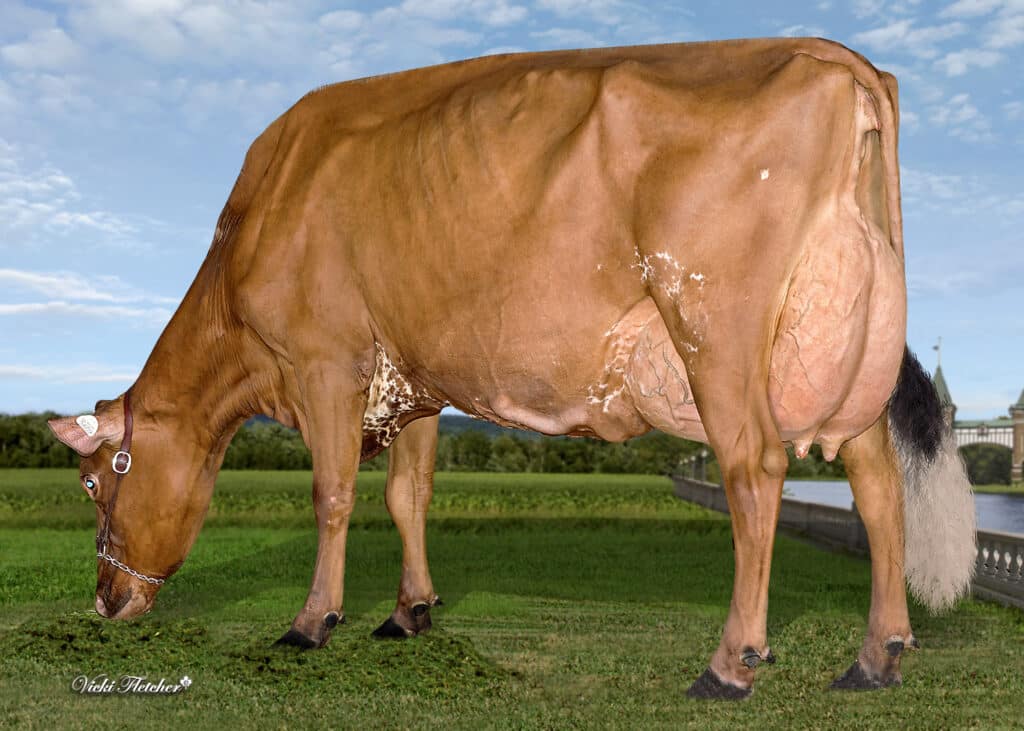
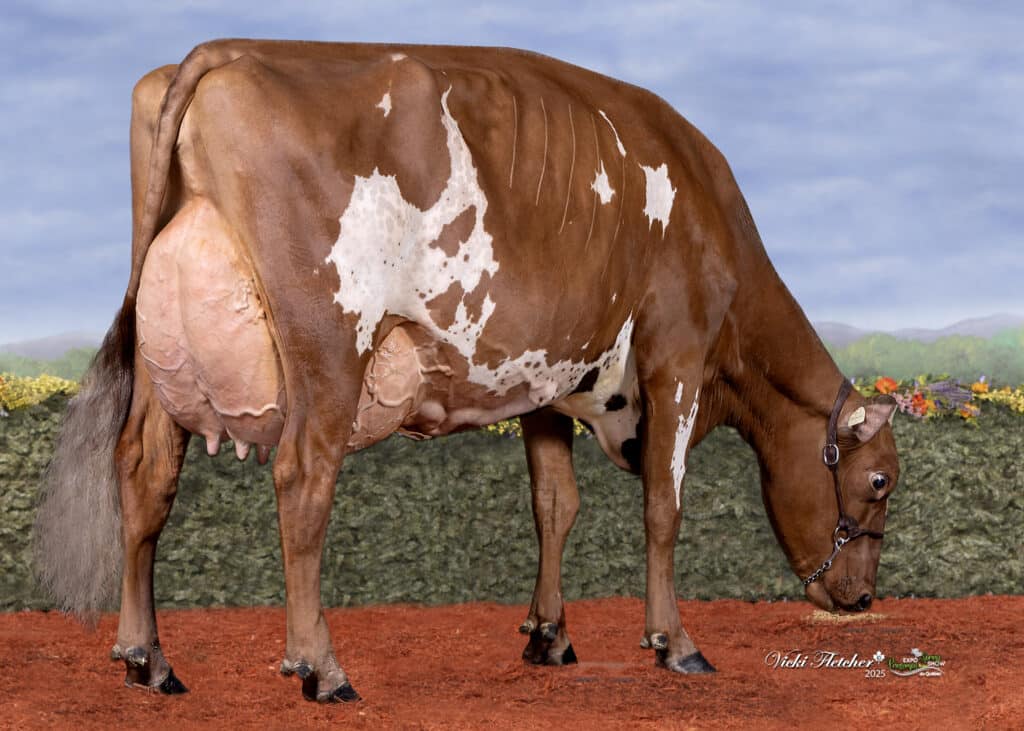
A narrative of the history of the Ayrshire breed in Canada, by Mr. Ross Butler, written in the early 1970s.
THE AYRSHIRE is the only breed the of dairy cattle to have originated in the British Isles. It was developed in the county of Ayr, in Southwestern Scotland.
While the real origin of the breed is somewhat obscure, it is established that before 1760 the Ayrshire had been developed to a point where it was recognized as a distinct breed.
The Ayrshire was developed to fill a certain and definite want. A dairy cow was needed. The breeds already in existence were not adapted to the climatic and feeding conditions of Scotland. The scarcity of pasture on the hill farms demanded a cow with a great rustling qualities to gather her food. Only the native cattle of the County could do this satisfactorily in this rugged land, So a few men set themselves the task of improving this native strain that had the health, vigor and stamina to withstand the harsh conditions and scanty rations foraged from the uncompromising fields.
About this time it was evident that many of the farmers of Ayr had heard of the new Dutch cattle from the Continent and that a number of these good milkers were being brought into England. So in Scotland, a man named John Orr, residing near Kilmarnock brought in some cows of this type. About 1750, the Earl of Marchmont purchased from the Bishop of Durham, England, several cows and a bull which were thought to have been Teeswater cattle, the forerunners of the Short-horn. Another local leader, John Dunlop also introduced from a distance cows that were conspicuous because of their size. These were thought to be of the Dutch breed and were soon known in the district as the Dunlop cows. It was about 1780 that this improved strain of the imported cows and the native stock may be said to be duly established and by 1790 the dis-trict was hecoming famous for the cattle which were going into neighboring counties. These new bloodlines were responsible for the change in color of the black and white of the native cattle of the period to the brown and white of the Ayrshire breed. But at any rate the fixed and well-established founda-tion of the breed was laid from 1760 to 1850 and their marked evolution is further established by the fact that the Highland and Agricultural Society first awarded prizes to the Ayrshire in 1814 as giving recognition to bulls and heifers.
Thus in piecing together such evidence as is available, is the background of the Ayrshire assembled. The ingenuity and painstaking care, in using the raw materials at hand when there was still no herd book, nor record of ancestry, and no rule to inhibit crossing with other breeds, but only by judicious matings these canny Ayrshire breeders continued to produce the most useful cattle for their purpose. In the years that have followed, the descendants of these constructive Scottish farmers who designed and produced the breed, have lived to see this stock accepted far and wide as an improving influence in the dairy industry of the world.
DEVELOPMENT
History tells us that dairy cattle. were from brought Great Britain to the Lower St. Lawrence about 1625 by the settlers who came to occupy the grant of territory made by King James I to Sir William Alexander under the great seal of Scotland. In view of the origin of these settlers, we may safely assume that they brought from Scotland the same strains of cattle that were the ancestors of the Ayrshire breed. We know that the importation of the first pure-bred Ayrshires is clearly traced the arrival of Scottish shins bringing them for the use of Windsor, Connecticut. However, in 1837 the Massachusetts Society for the Promotion of Agriculture made importations. Other introductions were continued at intervals for twenty to thirty years, then gradually ceased. Descendants of these cattle were bred and developed in the New England States and when importations from Scotland again were resumed within the last twenty years, the American Ayrshires were considerably dif-ferent animals from the modern breed as developed in Scot-land. They were largely red in color, with a lesser amount of white and were large, being known as the American type, while the Scotch type were predominantly white and more refined.
In recent years the importation of the breed to both the United States and Canada has been numerous and the imported animals of the Scotch type have set the standard character for the breed.
The hardy qualities of the Ayrshire make them very adaptable to certain regions in the Eastern States and in the Province of Quebec. Where grazing conditions are poor, the Ayrshire has thrived and established a name for her unique ability to gather a living and produce well under adverse con-ditions that would daunt her sister breeds. For this reason the stronghold of the Ayrshire in America may be found in the less productive sections of our country where she holds sway as queen and is firmly established as the thrifty farmer’s cow.
CHARACTERISTICS
In size the Ayrshires are a medum-sized breed with the cows averaging slightly above 1,000 lbs, in weight and the bulls running from 1,500 pounds upwards. They are often called the most beautiful of the dairy breeds because of the remarkably straight lines and smoothness on top. This is a particular trait of the breed, with the strongly carried backs setting a style and carried out over the rump and without a pronounced dip in the neck as in some of the other breeds. shire This symmetry is further noted in the beautiful udders of the best cows. The shapeliness, teat placement and veining makes the Ayrshire udder the acknowledged ideal and is a marked characteristic to distinguish this breed.
In color, the markings of a spotted mahogany, or dark brown and red of any shade and white in any proportions, do not blend but are distinct. The spots are often greatly broken up into small patterns making a distinctly beautiful effect of little islands of color interspersed in the white body color. There is usually a dark pattern near the neck and on the head, with it appearing next at the tail head and then over the body in varying degree. However, no discrimination is made in the coloring of the animals.
The most noticeable feature of this breed are the horns. They are upstanding and usually of a strong appearance, especially in the male. When the horns are well trained, they present a most graceful appearance and add dignity. The horns should have a waxy texture with an orange and yellow pigmentation becoming darker at the tips.
The head is strong and in the male has a very bold ap-pearance. There is a noticeable absence of loose skin or throat latch under the jaw. In this respect the Ayrshire has a cleaner throat than any breed and in the cows this makes a trim appearance about the head, denoting a thrifty doer. The neck is graceful and slim and clean-cut below. Perhaps these animals are smoother than others with a harmonious blending and roundness about the features of the body. The chest is full and deep; the chin is level; the thigh muscular and the udder is very well attached, running far forward on the belly and attached high behind. The sole or bottom of the udder is level, the teats placed far apart and of improved size over what they were in the early days of the breed’s development in this country.
In production, the Ayrshire is known as the 4% cow, this being the general average of the butterfat in the milk of the breed. The milk, while more white in color than some, is of a fine curd texture and is ideal for the manufacture of cheese. This was an important ideal in mind during the formative stages of the breed and much cheese was manufactured in the native land of the Ayrshire during the course of her development. To-day this type of milk is very adaptable in the feeding of babies, since the small curd digests easier than milk containing large fat globules.
Perhaps it is significant that the Ayrshire breeders have specialized on long-term or life-time production. This is a trait that makes for long-wearing cows that have the ability to produce consistently year after year in a profitable manner. Considerable stress is put upon this life-time production and such records are classified as Meritorious Production, the Gold Seal Class having 100,000 pounds of milk or over, to their credit. There are over forty Canadian Ayrshire cows qualified in this class. One hundred and fourteen have qualified in the Meritorious Production, Silver Seal class, with 75,000 pounds milk or over, to their credit. In the United States there are one hundred and eighty-four 100,000 pound cows.
In Canada. in the Record of Performance tests, 10,375 Ayrshire cows, representing all ages, have made an average yearly production in the 365-day period of 10,302 pounds of milk and 419 pounds of fat. Average fat per cent, 4.08%. Of these, the highest test in yearly production of any Ayrshire cow in the world is a Canadian cow, Ardgowan Valda, imported from Scotland, with 31,157 pounds of milk and 1,356 pounds of fat 4.35% in 365 days. The highest producing Canadian Ayrshire in life-time production and likewise the champion of the world is Macdonald Dorothy with 171,996 pounds milk, 7,039 pounds butterfat 4.24% made in nine lactations. This world’s record was previously held by Springburn Lovely Pet, also a Canadian Ayrshire, with 156,215 pounds milk and 6,452 pounds of butterfat and an average test of 4.13% butterfat. This was made in eleven lactations.
IMPROVEMENT
The Canada Ayrshire Breed-ers’ and Importers’ Association (with membership in Quebec and part of Eastern Ontario) was established in 1870. A second organization, the Dominion Ayrshire Breeders’ Association (with membership in Ontario and other parts of Canada, outside of Quebec) was formed in 1872. These two associations amalgamated in 1898 to forni the Canadian Ayrshire Breeders’ Association which exists to this day and very efficiently carries on the promotion of the breed in Canada. breeders. It has a membership of around 2,000
In the United States, the Ayrshire Breeders’ Association located at Brandon, Vermont, was organized in 1875 and incorporated in 1886. The total number of registrations made by this Association to date are 227,433 females and 63,577 males. It has a membership of 4,421.
In Scotland, the Ayrshire Cattle Herd Book Society was founded in 1877. Today the Ayrshire is still the leading dairy breed in Scotland and in addition it has become a chief factor in grading up the dairy stocks and founding modified breeds, particularly in Finland and Sweden. The Ayrshire has spread over Europe more perhaps than any other dairy breed with which we are familiar. They have also become important in New Zealand, South Africa and Central America.
As a dairy breed in our American environment, the Ayrshire appears to have a bright future. Combining as they do a remarkable degree of beauty and utility; of characteristic style and alertness; of grace and vigor; they are strong, hardy, capacious, and productive indeed, the beautiful Ayrshire will ever find an increasing place in the hearts of dairymen.